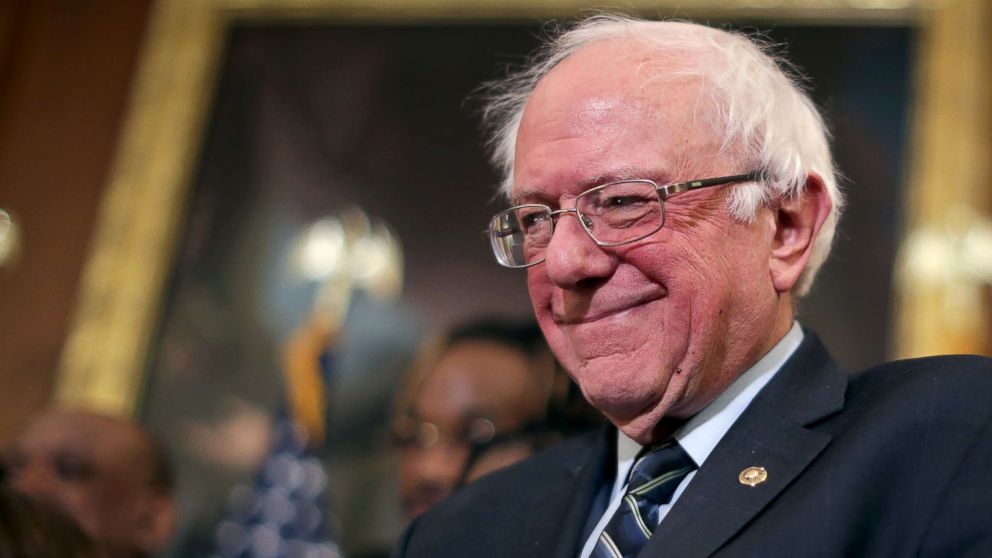Sen. Bernie Sanders (I-Vt.) proposed today eliminating all $1.6 trillion of student debt held in the United States, a significant escalation of the policy fight in the 2020 Democratic presidential primary two days before the candidates’ first debate in Miami.
Sanders is proposing the federal government pay to wipe clean the student debt held by 45 million Americans — including all private and graduate school debt — as part of a package that also would make public universities, community colleges and trade schools tuition-free.
Sanders proposes to pay for these plans with a tax on Wall Street that his campaign says will raise more than $2 trillion over 10 years, although some tax experts give lower revenue estimates.
Sanders was joined today by Rep. Ilhan Omar (D-Minn.), who will introduce legislation in the House to eliminate all student debt in the United States, as well as Rep. Pramila Jayapal (D-Wash.), co-chair of the Congressional Progressive Caucus, who has championed legislation to make public universities tuition-free.
Sanders helped popularize demands for tuition-free college during his 2016 presidential campaign run but did less to emphasize solutions for those who had already left school saddled with debt.
Since then, liberal Democratic lawmakers have called for increasingly aggressive government solutions for erasing existing student debt, with 2020 candidates Sen. Elizabeth Warren (D-Mass.) proposing $640 billion in student debt forgiveness and former housing secretary Julián Castro introducing a more modest debt forgiveness plan.
These proposals have faced fierce objections, including from some moderate Democrats, for giving taxpayer subsidies to educated Americans who, on average, have higher earnings than those with only a high school degree.
Advocates say the push reflects the growing recognition of the economic harm created by the nation’s soaring student debt burden, particularly on the millennial generation, which ballooned from $90 billion to $1.6 trillion in about two decades, according to federal data.
“This is truly a revolutionary proposal,” said Sanders, who announced the plan with the support of Rep. Alexandria Ocasio-Cortez (N.Y.) and a handful of other House Democrats. “In a generation hard hit by the Wall Street crash of 2008, it forgives all student debt and ends the absurdity of sentencing an entire generation to a lifetime of debt for the ‘crime’ of getting a college education.”
Sanders is proposing to pay for the legislation with a new tax on financial transactions, including a 0.5 percent tax on stock transactions and a 0.1 percent tax on bonds.
Such a levy would curb Wall Street speculation while reducing income inequality, according to a report by the Century Foundation, a left-leaning think tank, although conservatives warn it would stunt economic growth and investment.
Conservatives and moderate Democrats are likely to raise concerns about these student debt forgiveness plans.
They have pointed out that Democratic presidential candidates, including Sanders, have pushed more than a dozen expensive federal projects — including Medicare-for-all, the Green New Deal and large infrastructure improvements — projected to cost substantially more than the $1.5 trillion GOP tax law approved in 2017, at a time of already high deficits.
“The cost will march toward $3 trillion and benefit a lot of wealthy families and future high-earners,” said Brian Riedl, an analyst at the Manhattan Institute, a libertarian-leaning think tank. “Of all problems requiring a $3 trillion federal expenditure, the college costs of middle- and upper-class college graduates seem lower-priority.”
A fierce debate has raged in left-leaning policy circles as well as over whether canceling student debt offers too much help to families with higher incomes.
The top 40 percent of earners would receive about two-thirds of the benefits from Warren’s plan, according to Adam Looney, a former Treasury official under President Barack Obama who is now at the Brookings Institution, a center-left think tank.
That number is likely to be higher under Sanders’s plan, given that proposals by Warren and Castro do not call for wiping clean the debt of those earning over six figures.
Warren has proposed forgiving up to $50,000 in student debt for those earning under $100,000, or about 42 million people.
Under Castro’s plan, borrowers would not have to repay their loans until their income rose above 250 percent of the federal poverty line — about $64,000 for a family of four — after which it would be capped.
